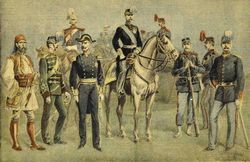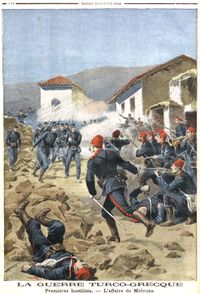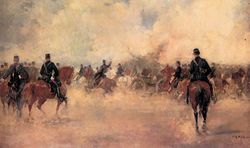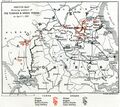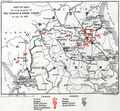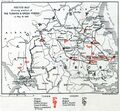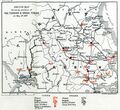الحرب التركية اليونانية (1897)
| الحرب التركية اليونانية (1897) | |||||||
|---|---|---|---|---|---|---|---|
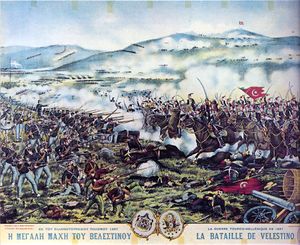 Painting of the Battle of Velestino | |||||||
| |||||||
| المتحاربون | |||||||
|
|
| ||||||
| القادة والزعماء | |||||||
|
Abdul Hamid II Halil Rifat Pasha Edhem Pasha Ahmed Hifzi Pasha Hasan Rami Pasha Hasan Tahsin Pasha |
Crown Prince Constantine Konstantinos Sapountzakis | ||||||
| القوى | |||||||
|
120,000 infantry[1] 1,300 cavalry[بحاجة لمصدر] 210 guns[بحاجة لمصدر] |
75,000 infantry[1] 500 cavalry 2,000 Italian volunteers 136 guns[بحاجة لمصدر] | ||||||
| الضحايا والخسائر | |||||||
|
1,300 dead[2][3] 2,697 wounded[2][3] |
672 dead 2,481 wounded 253 prisoners[2] | ||||||
الحرب التركية اليونانية 1897، كما تـُسمى حرب الثلاثين يوماً وتـُعرَف في اليونان بإسم سواد '97، كانت حرباً نشبت بين مملكة اليونان والدولة العثمانية. كان السبب المباشر لذلك هو مسألة وضع المقاطعة العثمانية كريت، التي طالما رغبت أغلبيتها اليونانية في الاتحاد مع اليونان. نتيجة لتدخل القوى العظمى بعد الحرب، تأسست الدولة الكريتية الذاتية تحت السيادة العثمانية في العام التالي، وكان الأمير جورج من اليونان أول مندوب سامي عليها.
كان هذا أول جهد حربي يـُختبـَر فيه العسكريون والسياسيون لليونان منذ حرب الاستقلال اليونانية في عام 1821. بالنسبة للدولة العثمانية، كان هذا أيضاً أول جهد حربي يـُختبـَر فيه القوات المسلحة المعاد تنظيمها. كان الجيش العثماني يعمل بتوجيه من بعثة عسكرية ألمانية بقيادة كولمار فرايهر فون در گولتس، الذي أعاد تنظيمه بعد الهزيمة في الحرب التركية الروسية (1877-1878).
أثبت الصراع أن اليونان كانت غير مستعدة على الإطلاق للحرب. الخطط والتحصينات والأسلحة كانت معدومة، وكتلة الضباط لم تكن مناسبة لمهامها، والتدريب كان غير كاف. ونتيجة لذلك، دفعت القوات العثمانية المتفوقة عددياً والأفضل تنظيماً وتجهيزاً وقيادة القوات اليونانية جنوباً خارج تساليا.[4][5]
خلفية
In 1878, the Ottoman Empire, according to the provisions of the Congress of Berlin, signed the Pact of Halepa which entailed the implementation of the organic law of 1868, promised but never implemented by the Ottoman government, which was to give Crete a status of wide-ranging autonomy. The Ottoman commissioners however repeatedly ignored the convention, causing three successive rebellions in 1885, 1888 and 1889. In 1894[بحاجة لمصدر] the Sultan Abdul Hamid II re-appointed Alexander Karatheodori Pasha as governor of Crete, but Karatheodori's zeal for the implementation of the agreement was met with fury by the Muslim population of the island and led to renewed clashes between the Greek and Turkish communities there in 1896.
To quell the unrest, Ottoman military reinforcements arrived while Greek volunteers landed on the island to support the Greek population. At the same time, the fleets of the Great Powers patrolled the Cretan waters, leading to further escalation. Nevertheless, an agreement was reached with the Sultan and the tensions receded. In January 1897, inter-communal violence broke out as both sides tried to consolidate their grip on power. The Christian district of Chania was set on fire and many fled to the foreign fleet anchored outside the city. A struggle for independence and union with Greece was declared by Cretan revolutionaries.
Greek Prime Minister Theodoros Deligiannis was subjected to fierce criticism by his adversary Dimitrios Rallis over his alleged inability to handle the issue. Continuous demonstrations in Athens accused King George I and the government of betrayal of the Cretan cause. The National Society, a nationalistic, militaristic organization that had infiltrated all levels of army and bureaucracy, pushed for immediate confrontation with the Ottomans.
إرهاصات الحرب
On 25 January 1897, the first troopships, accompanied by the battleship Hydra, sailed for Crete, where they disembarked two battalions of the Greek Army under Colonel Timoleon Vassos خارج خانيا. في 2 فبراير، بالرغم من ضمانات القوى العظمى بالسيادة العثمانية على الجزيرة، أعلن ڤاسوس، من طرف واحد، اتحاد كريت مع اليونان. The Powers reacted by demanding that Deligiannis immediately withdraw the Greek forces from the island in exchange for a statute of autonomy. The demand was rejected, and on 7 February, the first full-scale battle between Greeks and Turks occurred, when the Greek expeditionary force in Crete defeated a 4,000-strong Ottoman force في ليڤاديا.
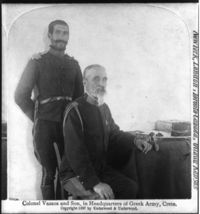
The Greek army was made of 3 divisions with 2 of them taking positions in Thessaly and one in Arta, Epirus. Crown Prince Constantine was the only general in the army. He took command of the forces on 25 March. The Greek army in Thessaly consisted of 38,000 men, 500 cavalry and 96 guns, while that of Epirus was made of 16,000 men and 40 guns.
The opposing Ottoman army was consisted of 8 infantry divisions and one cavalry. In the Thessaly front it consisted of 92,500 men, 1,300 cavalry and 186 guns, while in Epirus it could field 29,000 men and 24 guns. In addition, the Ottoman army was under the guidance of a German military mission under general Baron von der Goltz who had reorganized it after the defeat in the الحرب الروسية العثمانية (1877–1878). أدهم پاشا had the overall command of the Ottoman forces.
Apart from the evident difference in numbers, the two sides had also significant differences in the quality of armaments. The Ottoman army was already being equipped with its second generation of smokeless powder repeater rifles (Mauser Models 1890 and 1893), while the Greeks were equipped with the inferior single shot Gras rifle.
There was also the potential for a naval contest. In 1897 the Greek navy consisted of three Hydra class small battleships, one cruiser, the Miaoulis, and several older small ironclads and gunboats.[6] The Greek ships conducted bombardments of Turkish fortifications and escorted troop transports, however there was no major naval battle during the war. The Ottoman fleet had eight battleships and ironclads at least as large as the Greek battleships, and although most of these were obsolete designs the Osmanieh class had been rebuilt and modernized. The Turkish navy also had several smaller ironclads, two unprotected cruisers and a number of smaller ships including torpedo craft.[7] However, the Ottoman fleet had not been maintained, perhaps due to the Sultan’s fear of a strong navy becoming a power base for plots against the government, and in 1897 when called into action most of the ships were in poor condition and could not contest control of the sea beyond the Dardanelles. [8]
القوات المتقابلة
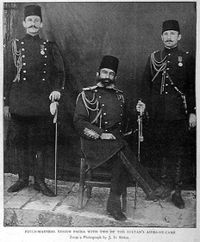
The Greek army was made of three divisions, with two of them taking positions in Thessaly and one in Arta, Epirus. Crown Prince Constantine was the only general in the army. He took command of the forces on 25 March. The Greek army in Thessaly consisted of 45,000 men,[9] 500 cavalry and 96 guns, while that of Epirus comprised 16,000 men and 40 guns.
The opposing Ottoman army consisted of eight infantry divisions and one cavalry. In the Thessaly front it consisted of 58,000 men,[9] 1,300 cavalry and 186 guns, while in Epirus it could field 26,000 men and 29 guns. Edhem Pasha had overall command of the Ottoman forces.
Apart from the obvious difference in numbers, the two sides had also significant differences in the quality of armaments. The Ottoman army was already being equipped with its second generation of smokeless powder repeater rifles (Mauser Models 1890 and 1893), while the Greeks were equipped with the inferior single-shot Gras rifle. There was also the potential for a naval contest. In 1897 the Greek navy consisted of three Hydra class small battleships, one cruiser, the Miaoulis, and several older small ironclads and gunboats.[6] The Greek ships conducted bombardments of Turkish fortifications and escorted troop transports, but there was no major naval battle during the war. The Ottoman fleet had eight battleships and ironclads at least as large as the Greek battleships, and although most of these were obsolete designs, the Osmaniye طراز had been rebuilt and modernized. The Turkish navy also had several smaller ironclads, two unprotected cruisers and a number of smaller ships including torpedo craft.[7] However, the Ottoman fleet had not been maintained, perhaps due to the Sultan’s fear of a strong navy becoming a power base for plots against the government, and in 1897 when called into action most of the ships were in poor condition and could not contest control of the sea beyond the Dardanelles.[8]
الحرب
On 24 March, 2,600 irregulars crossed the Greek border into Ottoman Macedonia in order to provoke disarray behind enemy lines by rousing locals against Ottoman administration. As a result, on the 6th of April Ethem Pasha mobilized his forces. His plan was to surround Greek forces and by using river Pineios as a natural barrier to push them back to Central Greece. Nevertheless, his rear forces were halted while the center of his formation gained ground altering his initial plans. The Greek plan was calling for a wider open field combat which ultimately would cost heavy casualties against an already superior opponent.
الجبهة التسالية
Officially, war was declared on 18 April when the Ottoman ambassador in Athens, Asim Bey, met with the Greek foreign minister announcing the cutting of diplomatic ties. Heavy battles occurred between 21-22 of April outside the town of Tyrnavos but when the overwhelming Ottoman forces aligned and pushed together the Greek general staff ordered withdrawal, spreading panic among soldiers and population. Larissa fell the on 27 April, while the Greek front was reorganized behind the strategic lines of Velestino, in Farsala. Nevertheless a division was ordered to head for Velestino thus cutting Greek forces in two, 60 km apart. Between 27-30th under the command of colonel Konstantinos Smolenskis the Ottoman advance was checked and halted.
On the 5th of May, three Ottoman divisions attacked Farsala forcing an orderly withdrawal of Greek forces to Domokos while on the eve of those events Smolenskis withdrew from newly-recaptured Velestion to Almyros. Volos fell into Ottoman hands in 8 May.
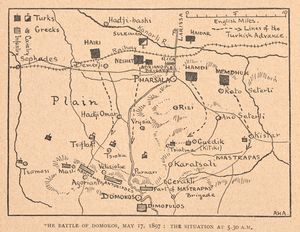
At Domokos, the Greeks assembled 40,000 men in a strong defensive position. The Turks had a total of about 70,000 troops, of whom about 45,000 were directly engaged in the battle.[10] On 16 May, the attackers sent part of their army around the flank of the Greeks to cut off their line of retreat but it failed to arrive in time. The next day the rest of their army made a frontal assault. Both sides fought hard. The Turks were held at bay by the fire of the defending infantry until their left flank defeated the Greek right. The Ottoman formation broke through forcing a renewed withdrawal. Smolenskis was ordered to stand his ground at the Thermopylae passage but on 20 May a ceasefire came in effect.
جبهة إپيروس
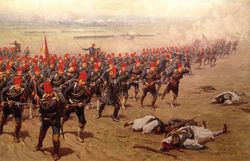
On 18 April, Ottoman forces under Ahmet Hıfzı Pasha attacked the bridge of Arta but were forced to withdraw and reorganize around Pente Pigadia. Five days later colonel Manos captured Pente Pigadia but the Greek advance was halted due to lack of reinforcements against an already numerically superior opposition. On 12 May, Greek forces and Epirot volunteers tried to cut off Preveza but were forced to retreat with heavy casualties.
الهدنة
On the 20th of September, peace was signed between the two sides. Greece was forced to cede minor border areas and to pay heavy reparations.[11] In order to pay the latter, the Greek economy came under international supervision. For the Greek public opinion and the military personnel the forced armistice was a humiliation, highlighting the unpreparedness of the country to fulfill its national aspirations (Megali Idea). This awareness laid the seeds for the revolution of 1909 of Goudi which called for immediate reforms in army, economy and society. Eventually, Eleftherios Venizelos would come to power and as a leader of the Liberal party, he would instigate a wide range of reforms which would transform the Greek state leading it to the victorious Balkan Wars two years later.
حرائط
الخسائر
| الجيش | اليونان | الدولة العثمانية | ||
|---|---|---|---|---|
| الضباط | الجنود | الضباط | الجنود | |
| قتلى الوغى | 32 | 640 | 52 | 1,059 |
| جرحى الوغى | 98 | 2,383 | 91 | 3,238 |
| أسرى الحرب | 1 | 252 | 1 | 15 |
| جرحى خارج المعارك | 5 | 337 | - | - |
| الإجمالي | 136 | 3,612 | 144 | 4,312 |
| الإجمالي | 3,748 | 4,456 | ||
الأعقاب
Despite the end of the war, the uprising on Crete continued – although with no further organized combat – until November 1898, when the Great Powers evicted Ottoman forces from the island to make way for an autonomous Cretan State under the suzerainty of the Ottoman Empire. Officially founded in December 1898 when Prince George of Greece and Denmark arrived on Crete to take up his duties as High Commissioner, the Cretan State survived until 1913, when Greece formally annexed the island.[12]
In Greece, the public awareness of the country's unpreparedness for war in pursit of its national aspirations laid the seeds for the Goudi coup of 1909, which called for immediate reforms in the Greek Army, economy, and society. Eventually Eleftherios Venizelos would come to power and, as a leader of the Liberal party, he would instigate a wide range of reforms that would transform the Greek state, leading it to victory in the Balkan Wars four years later.
انظر أيضاً
الهامش
- ^ أ ب Mehmet Uğur Ekinci: The Origins of the 1897 Ottoman-Greek War: A Diplomatic History. University Bilkent, Ankara 2006, page 80.
- ^ أ ب ت Clodfelter 2017, p. 197.
- ^ أ ب Dumas, Samuel; Vedel-Petersen, K. O. Losses of life caused by war. Clarendon Press. p. 57.
- ^ Erickson (2003), pp. 14–15
- ^ Pikros, Ioannis (1977). "Ο Ελληνοτουρκικός Πόλεμος του 1897" [The Greco-Turkish War of 1897]. Ιστορία του Ελληνικού Έθνους, Τόμος ΙΔ′: Νεώτερος Ελληνισμός από το 1881 ως το 1913 [History of the Greek Nation, Volume XIV: Modern Hellenism from 1881 to 1913] (in اليونانية). Ekdotiki Athinon. pp. 125–160.
- ^ أ ب Conways, p. 387-8
- ^ أ ب Conways, p. 389-92
- ^ أ ب Pears, Forty Years in Constantinople
خطأ استشهاد: وسم
<ref>غير صالح؛ الاسم "pears1" معرف أكثر من مرة بمحتويات مختلفة. - ^ أ ب David Eggenberger: An Encyclopedia of Battles: Accounts of Over 1,560 Battles from 1479 B.C. to the Present, Courier Dover Publications, 1985, ISBN 0486249131, page 450.
- ^ Report of General Nelson Miles.
- ^ Erick J. Zurcher. Turkey, A Modern History. London and New York: Tauris, 2004, p. 83, ISBN 1860649580.
- ^ McTiernan, pp. 35-39.
ببليوگرافيا
- Ekinci, Mehmet Uğur (2006). The Origins of the 1897 Ottoman-Greek War: A Diplomatic History (PDF) (M.A. thesis). Ankara: Bilkent University. Retrieved 2010-05-10. Revised edition: Ekinci, Mehmet Uğur (2009). The Unwanted War: The Diplomatic Background of the Ottoman-Greek War of 1897. Saarbrücken: VDM Verlag Dr. Müller. ISBN 978-3-639-15456-6.
- Gardiner, Robert, ed. (1979). Conway's All the World's Fighting Ships 1860—1905. New York: Mayflower Books. ISBN 0-8317-0302-4.
- Pears, Sir Edwin. “Forty Years in Constantinople” (1916)
وصلات خارجية
 Media related to الحرب التركية اليونانية (1897) at Wikimedia Commons
Media related to الحرب التركية اليونانية (1897) at Wikimedia Commons- Onwar.com on the First Greco-Turkish War
- CS1 uses اليونانية-language script (el)
- CS1 اليونانية-language sources (el)
- Articles with unsourced statements from September 2016
- Articles with hatnote templates targeting a nonexistent page
- Articles with unsourced statements from October 2010
- 1897 في اليونان
- نزاعات 1897
- حروب اليونان
- حروب الدولة العثمانية
- العلاقات التركية اليونانية
- تاريخ تساليا
- 1897 في الدولة العثمانية
- القرن 19 في الدولة العثمانية
- السلطان عبد الحميد الثاني

